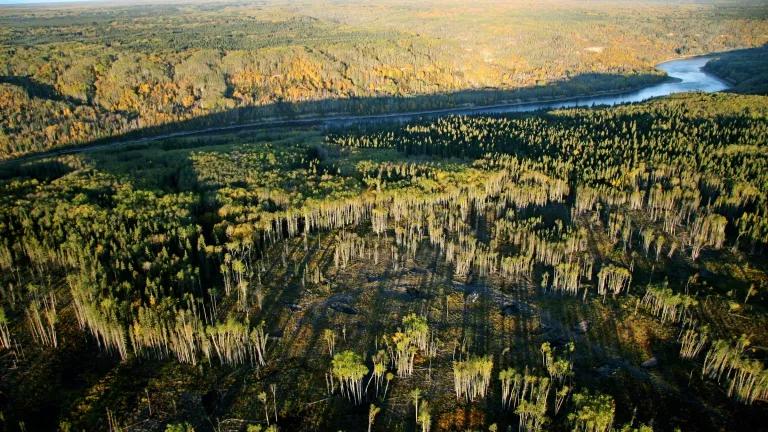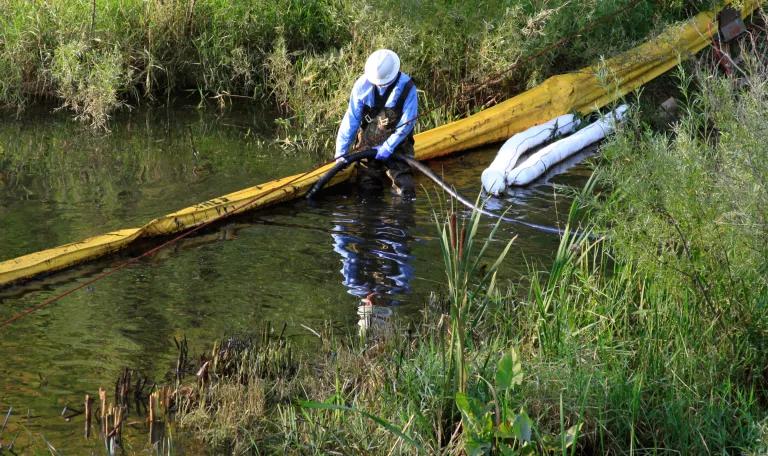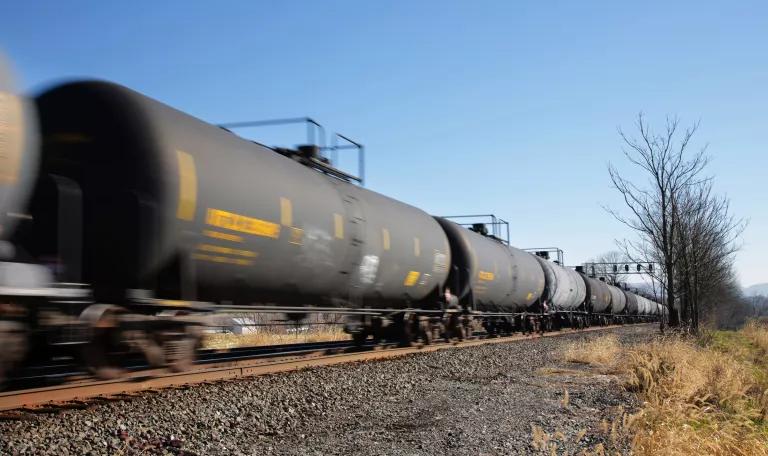10 Threats from the Canadian Tar Sands Industry
At every turn, the tar sands invasion would put people and the environment in harm's way.

The Athabasca River in Alberta, Canada
David Dodge/CPAWS/Flickr
The battle over Keystone XL was long and polarizing, with activists and environmental advocates standing up to big polluters and urging President Obama to stop the dirty tar sands pipeline that would cut through the heart of America.
But KXL was just one front in the larger war to stop tar sands oil from invading our country from sea to shining sea. Despite economic losses, Big Oil remains determined to triple production of the dirty crude over the next two decades, and it has plans to flood the United States with up to six million barrels a day.
The tar sands invasion will pollute our land, air, and water if we don't stand up and say no to the real and widespread threats it represents.
1. Digging up tar sands wreaks havoc on Alberta's boreal forest.
In northern Canada, mining operations are digging up and flattening forest to access the tar sands oil below. They're already leveling trees and destroying wetlands at alarming rates, putting millions of migratory birds, caribou, bears, wolves, and endangered species like the whooping crane at risk. Boreal wetland ecosystems also trap massive amounts of carbon—so the more the forest is developed, the more climate-wrecking gas is released into the atmosphere. How much more can it take?
2. The production process wastes enormous quantities of freshwater.
Tar sands mines use 2.4 barrels of freshwater for every barrel of tar sands produced. Companies get the water from the Athabasca River—one of North America's longest free-flowing rivers—and nearly all of it ends up too contaminated to return. The Athabasca is already at risk of being overdrawn, and adding more tar sands operations would imperil the river, its surrounding wetlands, and the people and wildlife that depend on them.
3. Tar sands development produces huge amounts of toxic wastewater.
Mining companies don't send the toxic, sludgy wastewater left over from tar sands production back into the river—at least not directly. Instead, they store it—three million gallons' worth every day—in vast, open pools. But these tailing ponds, as they're called, are leaking into rivers like the Athabasca, harming wildlife and increasing cancer rates in humans. If Alberta can't handle the toxic sludge it already has, how will it deal with more?
4. Burning tar sands oil creates more pollution than regular crude.
Because of its sludgy composition, mining and refining tar sands oil demands an enormous amount of energy. Tar sands generate 17 percent more carbon emissions than conventional oil. Ramping up dirty tar sands oil production means a giant step back in the fight against climate change, and that's the last thing we need.
5. A web of new pipelines will fan out from Alberta's tar sands pits.
If Big Oil gets its way, a sprawling web of new or expanded pipelines—some larger than Keystone XL—would carry millions of additional barrels of tar sands crude from Alberta every day. The Alberta Clipper pipeline would feed 800,000 barrels daily into the Great Lakes region, while Energy East's would transport more than a million barrels to the East Coast. A similar amount would be moved westward by the Trans Mountain pipeline, feeding tankers, barges, and rail cars that would then carry it south—a crafty workaround to that KXL problem.
6. We aren't prepared to deal with tar sands spills.
When tar sands pipelines rupture or tanker cars derail and spill the crude over land and water supplies across the United States, we face an especially big challenge. Unlike conventional oil, tar sands is heavy, stubborn, and difficult to clean—and traditional response methods don't cut it. Just look at the 2010 spill that sent more than 800,000 gallons of heavy tar sands crude spewing into Michigan's Kalamazoo River. Five years and more than $1 billion later, the river is still contaminated. The cleanup is the longest and costliest in U.S. history so far.

Cleanup of the Kalamazoo River oil spill in Battle Creek, Michigan
Kevin Martini/Flickr
7. Exporting tar sands will put rivers and coastlines at risk of spills.
Once the millions of barrels of tar sands oil reach the end of these pipelines, an armada of supertankers and barges will be waiting to haul them away—threatening marine habitats and beaches and crowding iconic waterways like the Hudson River and the Great Lakes, posing a much greater chance of a catastrophic spill. And worse, because tar sands crude contains a unique brew of chemicals, spills in oceans, lakes, or rivers can't be cleaned up with conventional technology. We should probably work on figuring that out first.
8. Rail cars carrying tar sands crude will pass through densely populated areas.
Transporting tar sands oil by rail has already proven itself to be risky business: "Bomb trains" keep jumping the tracks, setting towns ablaze, and contaminating water supplies. And the problem will only get worse with expanded tar sands development. Do we really want mile-long trains of rupture-prone, aging tank cars rolling through big cities like Los Angeles and Seattle?

An oil tanker train
Dervin Witmer/Shutterstock
9. Tar sands oil refineries produce dangerous petcoke waste.
Another hazardous byproduct of tar sands production is petroleum coke, or petcoke, a dusty black residue that's left over from the refining process. Tar sands produce a lot of it—so much that some refineries have started sending the toxic dust to residential areas like Chicago's Southeast Side, where it sits uncovered in massive piles and blows through the neighborhood whenever the wind kicks up. A boost in tar sands development will mean more petcoke piles coming to a town near you.
10. Low-income communities will be disproportionately impacted.
Perhaps unsurprisingly, much of the infrastructure supporting the Tar Sands Invasion will exact an especially high toll on low-income communities located in railway corridors, near oil refineries and crude-by-rail terminals, and adjacent to petcoke waste sites. We don't have to look further than Alberta's First Nations or the town of Port Arthur, Texas (where the KXL pipeline would have ended), to see the devastating harm the oil industry can cause. From start to finish, tar sands oil is dirty and dangerous, and we need to stop the invasion before it's too late.
This NRDC.org story is available for online republication by news media outlets or nonprofits under these conditions: The writer(s) must be credited with a byline; you must note prominently that the story was originally published by NRDC.org and link to the original; the story cannot be edited (beyond simple things such as grammar); you can’t resell the story in any form or grant republishing rights to other outlets; you can’t republish our material wholesale or automatically—you need to select stories individually; you can’t republish the photos or graphics on our site without specific permission; you should drop us a note to let us know when you’ve used one of our stories.


The Unlikely Takedown of Keystone XL
Water Is Life—from Standing Rock to Oaxaca’s Mixtecan Highlands
Go Easy on the Salt